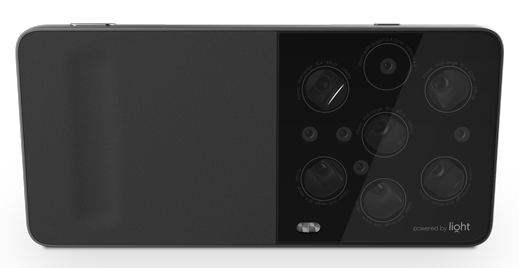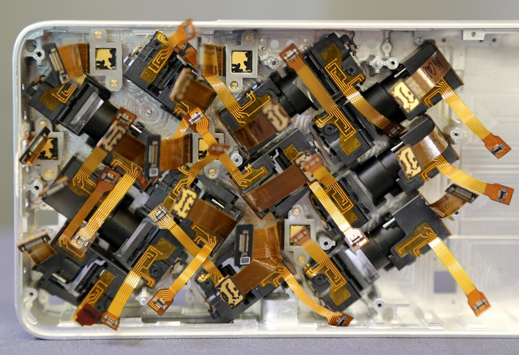A Way to Get Much-Higher-Resolution Selfies
Most digital cameras are limited by a key aspect of their design: they have one lens and one image sensor. Light hits the lens and is directed at the sensor to produce a picture. A photography startup called Light is not making most digital cameras, though.

Rather than hewing to this one-to-one ratio, Light aims to put a bunch of small lenses, each paired with its own image sensor, into smartphones and other gadgets. They’ll fire simultaneously when you take a photo, and software will automatically combine the images. This way, Light believes, it can fit the quality and zoom of a bulky, expensive DSLR camera into much smaller, cheaper packages—even phones.
Light is still in the early stages, as it doesn’t yet have a prototype of a full product completed. For now it just has camera modules whose pictures can be combined with its software. But the startup says it expects the first Light cameras, with 52-megapixel resolution, to appear in smartphones in 2016.
Light plans to announce a deal on Tuesday with Foxconn, the world’s largest contract electronics manufacturer. Foxconn is licensing Light’s technology for use in mobile devices and is investing an undisclosed amount in the company. (Last year, Light raised $9.7 million from investors including Bessemer Venture Partners and Charles River Ventures.)
Light is taking advantage of radical declines in the cost, weight, and size of optics that have happened as smartphones took over the cell phone market and, for many people, became their go-to camera. Unlike costly camera lenses that are made of glass, most smartphone camera lenses are made of plastic that’s stamped from molds. It is a much cheaper process, but the quality of images may not be as good. And you rarely see optical zoom squished onto a smartphone camera. Instead such devices use digital zoom, enlarging a portion of the image.
I got an inkling of what Light is up to in its office in Palo Alto, California, where an open-face metal box roughly the size of a rearview mirror sat on a conference table. It contained an array of 16 camera modules with focal lengths of 35, 70, and 150 millimeters, and tiny cables sticking up in the air like tadpole tails. The modules are operational, I was told, and were meant to show the kind of array the startup envisions being used in self-driving cars or home security cameras.
Each module was laid on its side, and I could see how light would come in from above, reflect off a mirror, and travel down the lens barrel to an image sensor.

The idea, Light cofounder and chief technology officer Rajiv Laroia explains, is that when you take a picture with a Light camera it’s taking several pictures at the same time from slightly different perspectives (though it won’t show them to the user). The level of zoom that the user selects determines which modules will fire when he takes a picture, and where the mirror contained in each module moves to capture light. It could aim for light straight ahead, or off at an angle, for instance. The resulting shots are then digitally combined in a way that emulates a much bigger camera lens.
The software should also make it possible to adjust the focus on photos after they’ve been taken—a trick that also is possible with a camera from Lytro (see “10 Breakthrough Technologies 2012: Light-Field Photography”). Lytro does this, however, by placing an array of lenses atop one image sensor.
Light didn’t show me any working camera arrays, though I did see an image of one of the company’s engineers that was shot with a test array of four eight-megapixel sensors and combined with software. In a close-up of her face, her hair and the background were quite sharp.
Getting this kind of clarity on a smartphone may satisfy shutterbugs, but it also would likely require the devices to be chunkier. Light says that embedding its camera module in a smartphone would make the overall device about as thick as a current smartphone in a case—running counter to the ever-slimmer trend for handsets. And it’s likely to make phones more expensive, too. Light CEO Dave Grannan expects a camera using Light’s technology to add about $50 to $60 to the bill of materials for the phone, which is much higher than the cost of the cameras on current high-end handsets like the iPhone 6 Plus or Samsung Galaxy S6 Edge.
David Brady, leader of Duke University’s imaging and spectroscopy program and CEO of a camera-array company called Aqueti, says Light’s idea is a good one, though a number of companies have so far failed to commercialize similar technology.
He also points out that there’s currently no good way for the average person to share very high-resolution photos, which generate very big files. Though you may take a photo today with an eight-megapixel camera, when you post it on Facebook, your friends will see a much lower-resolution image.
Still, he says, “There’s no question what they’re doing is the future of cameras.”
Keep Reading
Most Popular
Large language models can do jaw-dropping things. But nobody knows exactly why.
And that's a problem. Figuring it out is one of the biggest scientific puzzles of our time and a crucial step towards controlling more powerful future models.
The problem with plug-in hybrids? Their drivers.
Plug-in hybrids are often sold as a transition to EVs, but new data from Europe shows we’re still underestimating the emissions they produce.
Google DeepMind’s new generative model makes Super Mario–like games from scratch
Genie learns how to control games by watching hours and hours of video. It could help train next-gen robots too.
How scientists traced a mysterious covid case back to six toilets
When wastewater surveillance turns into a hunt for a single infected individual, the ethics get tricky.
Stay connected
Get the latest updates from
MIT Technology Review
Discover special offers, top stories, upcoming events, and more.